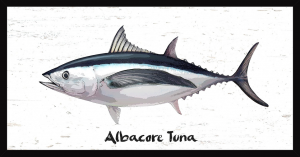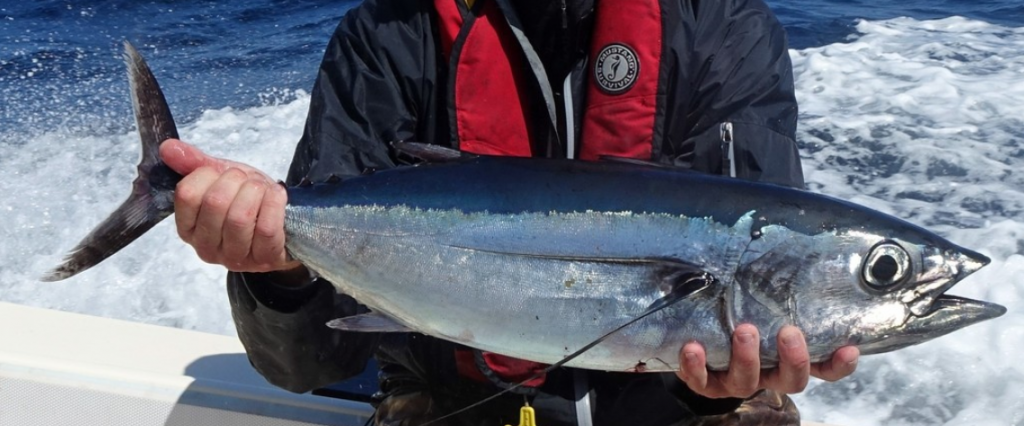
Albacore Tuna a Complete Guide to this Delicious Versatile Fish
Discover everything about albacore tuna and how to catch them. Your ultimate guide to enjoying this amazing fish.
Albacore tuna is such a beloved fish around the world. It has a mild flavor and impressive health benefits, this fish has something for everyone. Below we will dive deep into what makes albacore tuna a standout choice for fishing and eating.
| Albacore Tuna Info Albacore Tuna Scientific Name – Thunnus alalunga Albacore Tuna Local Name – Albies, long-finned tuna Albacore Tuna Size – 2 to 4 feet (60 to 120 cm) Albacore Tuna Weight – 20 to 60 pounds (9 to 27 kg) Albacore Tuna Mercury – Medium Albacore Tuna Price – Medium |
What is Albacore Tuna
Albacore tuna (Thunnus alalunga) is a unique species of tuna known mostly for its long pectoral fins, streamlined body, and mild, delicate flavor. It is one of the smaller tuna species with metallic dark blue top and silver white belly. Albacore tuna is often confused with juvenile bigeye tuna.

Like most tuna, Albacore are found in temperate and tropical oceans worldwide but tend to thrive in deeper, cooler waters compared to other tuna species. Most albacore tuna reach reproductive maturity at 5-7 years of age. Spawning occurs in during the summer months of their respective region.
While yellowfin is prized for sushi and sashimi due to its vibrant color and firm texture, and bluefin is a luxury delicacy with a buttery rich taste, albacore tuna is celebrated for its versatility in both fresh and canned forms. Its leaner, milder profile makes it perfect for lighter dishes and health conscious meals.
Albacore Fishing Tips and Techniques
Fishing for albacore tuna can be a thrilling experience if you are prepared with the right techniques. Look for temperature breaks and offshore areas where warm and cold currents meet as these are prime spots for albacore. They prey opportunistically on small fish, squid, and planktonic crustaceans.
Albies are commonly located in the Pacific, Atlantic, and Indian Oceans, with notable populations along the coasts of North America, Europe, and parts of Asia. In the Pacific they are often found from California to Hawaii and down to the South Pacific islands. They also thrive in the Mediterranean Sea and areas around New Zealand and Australia.
Albacore tuna are migratory following ocean currents and temperature changes, often favoring waters between 60-68°F (15-20°C). These pelagic fish typically inhabit open ocean areas but can be found near underwater seamounts and temperature breaks where food sources are abundant.
Pay attention to bird activity as diving seabirds often signal schools of albacore nearby. Lastly reminder to maintain your gear with strong lines and sharp hooks, albacore are powerful fighters and will test your setup.
Catching Albacore Tuna By Trolling
It will be difficult to catch tuna from a boat that stands still in the water since they travel in large schools at high speed. We recommend to use trolling as your primary method. Glittery baits that are designed to troll at high speed can be used in the day time and in the the late evening you can use darker color lures. Lures like cedar plugs, feathers, or diving plugs will best mimic their prey. The ideal length of the lure for catching albacore tuna is 3-4 inches.
If using live bait, use anchovies or sardines. When you use a anchovies bait, you must hook it with the mouth closed. The hook must be strong and sharp, for example, the 4/0 hooks.
The baits or lures are to be trolled in the correct position behind the boat.
For trolling techniquest please check out Trolling for Tuna post.
Keep your boat speed steady at around 6-8 knots to attract their attention. To get the tuna to swim up to the surface, you must stir up some commotion. For example dragging teasers behind the boat. When they are stirred in excitement, they will come up and bite on any lures or bait they see. You can mix 5 – 6 lures or baits to create your own school of fish in order to attract the tuna up to the surface.

Albacore Tuna Eating
Albacore fish flesh is pink in color and will turn white when you cook it. Most of the Albacore tuna caught are young and weigh in between 10 – 30 pounds. Because they are young there is a lower accumulation of mercury in their flesh. Albacore tuna is rich in protein, omega 3, vitamins B12 and D. Albacore Tuna are often used for canned tuna.
Albacore Fish Recipes
Albacore tuna is incredibly versatile making it a favorite in kitchens worldwide. For fresh albacore tuna steaks, popular preparation methods include grilling, searing, baking, and poaching. Grilling enhances its mild flavor with a smoky edge, while searing creates a perfect crust and keeping the center tender. Baking is great for a hands off approach especially with marinades. Poaching in broth or oil keeps it moist and flaky.
Albacore fish recipes include a simple lemon garlic marinade for grilling or a sesame-crusted seared steak served with a soy dipping sauce. For canned albacore tuna, the possibilities are endless. Examples are to toss it into a fresh salad with avocado and tomatoes, bake it into a comforting tuna casserole with cheese and breadcrumbs, or mix it into pasta with garlic, olive oil, and capers for a quick Mediterranean inspired dish.
Albacore Tuna Frequently Asked Questions (FAQs)
Is albacore tuna the same as “white tuna”?
Yes, albacore tuna is often referred to as “white tuna” because of its pale almost white flesh, which is lighter compared to other tuna species like yellowfin or skipjack. This term is commonly used on canned tuna labels to indicate albacore.
How does mercury in albacore tuna compare to other fish?
Albacore tuna generally has higher mercury levels than smaller fish like salmon or sardines but lower levels than larger predatory species like swordfish and bluefin tuna. Canned albacore typically contains more mercury than canned light tuna (usually skipjack), so it’s recommended to consume it in moderation, especially for pregnant women and young children.
Can you eat albacore tuna raw?
Yes, albacore tuna can be eaten raw if it is sushi grade or specifically labeled as safe for raw consumption. Ensure the fish has been properly frozen to eliminate parasites and sourced from a reputable supplier to minimize risks. Its mild flavor and tender texture make it a popular choice for sushi, sashimi, and poke.
What is the healthiest tuna to eat?
Albacore tuna is incredibly nutritious. High in protein, low in fat, and features many essential vitamins and minerals, it’s an excellent addition to any healthy diet.
Albacore tuna isn’t just another fish, it is a nutritional powerhouse and a versatile ingredient that’s easy to cook and enjoy. From its heart healthy benefits to its role in sustainable seafood, there is every reason to go fishing for it and make it a staple in your kitchen.
Keywords
- white tuna
- albacore fishing
- albacore fish recipes
- albacore tuna nutrition
- canned albacore tuna recipes
- fresh albacore tuna
- omega-3 fatty acids in tuna
- sustainable seafood
- mercury levels in albacore tuna
- grilling albacore tuna
- seared albacore tuna
- health benefits of tuna
- albacore tuna steak marinade
- tuna salad ideas
- catching albacore
- best canned tuna brands
- what is albacore tuna
Trolling is a tried and traditional technique for tuna. Visit this post for detailed Tuna Trolling Info
Check out other species of tuna.
 Penn Tuna Fishing Rod & Reel Combo
Penn Tuna Fishing Rod & Reel Combo Fishing Pliers and Knife Combo
Fishing Pliers and Knife Combo View Best Tuna Fishing Lures
View Best Tuna Fishing Lures